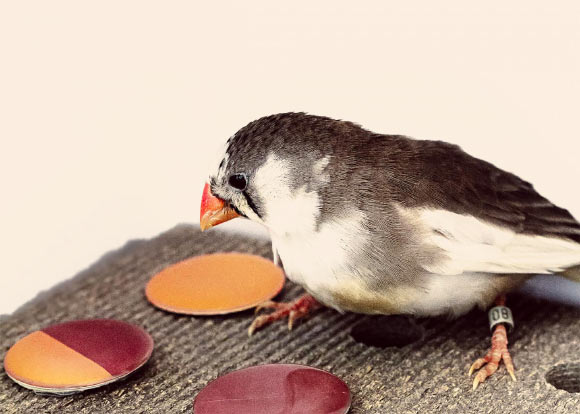The rainbow of visible colors varies over a continuous range of wavelengths, but small songbirds called zebra finches (Taeniopygia guttata) break it into discrete colors much like humans, an international team of scientists reports in the journal Nature.

Due to a phenomenon called categorical perception, zebra finches partition the range of hues from red to orange into two discrete categories. Image credit: Ryan Huang, TerraCommunications LLC.
The team, headed by Duke University’s Professor Stephen Nowicki, tested the ability of zebra finches to tell whether colors are the same or different.
Using different pairwise combinations of eight hues representing the range of male beak colors, the researchers showed 26 females a set of quarter-sized paper discs, some two-toned and some solid colored.
The birds learned that each time they flipped over a two-toned disc with their beak, they found a millet seed treat hidden underneath. If they flipped over a solid colored disc, they got nothing.
Picking a particular disc first before the others was a sign that a bird perceived it as having two colors rather than one.
Some trials involved color pairs that were closer together on the color spectrum, while others involved pairs that were farther apart.
Females had no difficulty discriminating the most dissimilar pairings. What was interesting was how they treated the various hues in between.
The findings suggest a threshold effect at work — a sharp perceptual boundary where orange turns to red.
The birds were much better at distinguishing two colors from opposite sides of the boundary than pairs from the same side, even when all pairs were all equally far apart on the color spectrum.
“This study didn’t test whether the birds preferred some disc hues over others,” said co-lead author Dr. Patrick Green, a postdoctoral researcher at Duke University.
“But the results shed light on what might be happening when a female gazes at a potential mate.”
“If the birds lump all hues on one side of a certain redness threshold into the same category, then at least when it comes to beak color, females may not be picky about whether a potential mate is Mr. Perfection or Mr. Good Enough.”
“What we’re showing is: he’s either red enough or not,” Professor Nowicki said.
The scientists don’t yet know if the threshold between what humans perceive as ‘orange’ versus ‘red’ is the same for birds.
But the findings lend support to the idea that such color labels have deep biological roots, and aren’t just arbitrary divisions shaped by human culture or language.
Categorical color perception in zebra finches isn’t likely to be just the result of variation in how well the light-sensitive cells in the birds’ eyes distinguish different wavelengths. It may be in their minds.
“What hits the retina is not always what we see. Signals from the retina are conveyed to the brain for decoding,” said co-lead author Dr. Eleanor Caves, a postdoctoral researcher at Duke University.
“We’re taking in this barrage of information, and our brain is creating a reality that is not real,” Professor Nowicki said.
“Categorical perception may be a cognitive shortcut that helps animals make tough decisions in the face of noisy, limited or ambiguous information.”
“Categorical perception — what we show in zebra finches — is perhaps one strategy the brain has for reducing this ambiguity,” Dr. Caves said.
“Categories make it less crucial that you precisely interpret a stimulus; rather, you just need to interpret the category that it’s in.”
_____
Eleanor M. Caves et al. Categorical perception of colour signals in a songbird. Nature, published online August 1, 2018; doi: 10.1038/s41586-018-0377-7







